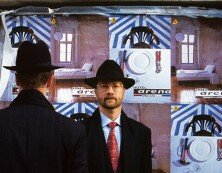This unquantifiable realm of industrial design is the more challenging to work with, yet bears the greatest potential for creating meaning and emotional impact. As designers and design researchers, we usually find our way through this complexity by using a balance of critical thinking and intuition.
When I was studying industrial design at the Kunstakademie in Stuttgart our professor, Richard Sapper, urged us to take the time to discuss and develop an idea about the future world we would like to live in. In his opinion this was very important for us as designers, because only if we had formed a strong personal vision and were motivated by an idealistic drive, would we be able to shape products that would have lasting meaning.
As much as this resonated with me back then, it still does today. My interest in the thinking processes associated with design has continued to manifest itself throughout my professional journey as well as in terms of my current role in design research & strategy at Teague.
Within design and other creative professions, I think there is a substantial difference between a reactive approach and a critical approach. With a reactive approach we run the risk of coming up with ideas that merely emulate “the mood of the time†without ever asking the bigger question if we even needed this product or feature in the first place. Through a critical approach we can try to challenge current paradigms, to bring in differentiated awareness and understanding, as well as aesthetic and cultural sensibility, thought leadership and a future perspective. Ultimately the energy and care we invest into this process is expressed in the emotional quality and innovation of our products.
It’s not always easy to incorporate such an approach within our projects since we are all driven by the concrete needs of our clients, ever tighter deadlines and fast product cycles. In my experience, however, taking time for critical exploration will pay off later; the depth of the thinking process works itself into the feel of the product and its associations. We are creating greater “emotional product inertiaâ€, we make our products more sustainable by ensuring that they will stay relevant over time.
I think some of this work has to happen outside of the actual project realm. At the highest level the goal is to extend our thinking, by relating our design problems to the bigger context of our time, it’s philosophy, it’s socio-cultural fabric, it’s challenges and show how they relate to the past as well as to possible futures. I think we benefit highly from establishing a cross disciplinary discourse to other creative disciplines who are struggling with some of the same questions, interpreting them in their way and shaping the future in their fields, such as architecture, art, fashion, music and writing to name a few. Through a stronger vision of the whole we are enabled to give our projects more relevance and impact.
We industrial designers have to work within the practical, emotional and philosophical tensions of our time. It seems that the 21st century is providing ample opportunity and challenge for us to shape the future in meaningful ways.
The question that Richard Sapper asked us 1 ½ decades ago of course has not lost its relevance: “What is our vision for the future and how can we try to bring a little bit of that vision to life in the next product we design?â€












Discussion (1) Comment